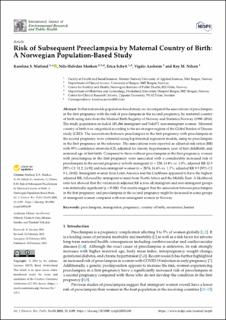| dc.description.abstract | In this nationwide population-based study, we investigated the associations of preeclampsia in the first pregnancy with the risk of preeclampsia in the second pregnancy, by maternal country of birth using data from the Medical Birth Registry of Norway and Statistics Norway (1990–2016). The study population included 101,066 immigrant and 544,071 non-immigrant women. Maternal country of birth was categorized according to the seven super-regions of the Global Burden of Disease study (GBD). The associations between preeclampsia in the first pregnancy with preeclampsia in the second pregnancy were estimated using log-binomial regression models, using no preeclampsia in the first pregnancy as the reference. The associations were reported as adjusted risk ratios (RR) with 95% confidence intervals (CI), adjusted for chronic hypertension, year of first childbirth, and maternal age at first birth. Compared to those without preeclampsia in the first pregnancy, women with preeclampsia in the first pregnancy were associated with a considerably increased risk of preeclampsia in the second pregnancy in both immigrant (n = 250; 13.4% vs. 1.0%; adjusted RR 12.9 [95% CI: 11.2, 14.9]) and non-immigrant women (n = 2876; 14.6% vs. 1.5%; adjusted RR 9.5 [95% CI: 9.1, 10.0]). Immigrant women from Latin America and the Caribbean appeared to have the highest adjusted RR, followed by immigrant women from North Africa and the Middle East. A likelihood ratio test showed that the variation in adjusted RR across all immigrant and non-immigrant groups was statistically significant (p = 0.006). Our results suggest that the association between preeclampsia in the first pregnancy and preeclampsia in the second pregnancy might be increased in some groups of immigrant women compared with non-immigrant women in Norway. | en_US |

